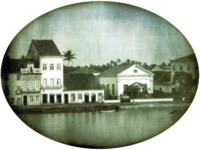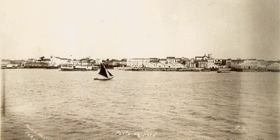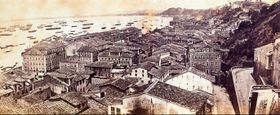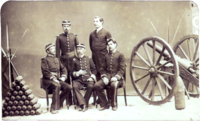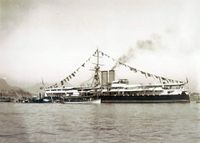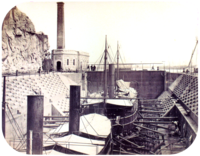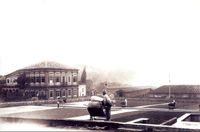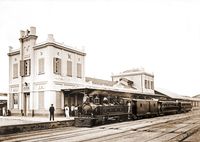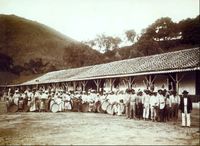امبراطورية البرازيل
امبراطورية البرازيل Império do Brasil | |||||||||||
|---|---|---|---|---|---|---|---|---|---|---|---|
| 1822–1889 | |||||||||||
Motto: Independência ou Morte! "الاستقلال أو الموت!" | |||||||||||
النشيد: Hino da Independência (1822–1831) "نشيد الاستقلال" Hino Nacional Brasileiro (1831–1889) "النشيد الوطني البرازيلي" | |||||||||||
 امبراطورية البرازيل في أقصى اتساع لها، 1822–1828، وتضم المقاطعة السابقة سيسپلاتينا | |||||||||||
| المكانة | امبراطورية | ||||||||||
| العاصمة | ريو دي جانيرو | ||||||||||
| اللغات الشائعة | البرتغالية | ||||||||||
| الدين | الكاثوليكية | ||||||||||
| الحكومة | ملكية دستورية | ||||||||||
| امبراطور البرازيل | |||||||||||
• 1822–1831 | پدرو الأول | ||||||||||
• 1831–1889 | پدرو الثاني | ||||||||||
| رئيس الوزراء | |||||||||||
• 1843–1844 | ماركيز پارانا (أمر واقع) | ||||||||||
• 1847–1848 | ڤايكونت كاراڤلاس الثاني (منصب مستحدث) | ||||||||||
• 1889 | ڤايكونت اورو پرِتو (الأخير) | ||||||||||
| التشريع | الكونگرس الوطني | ||||||||||
| مجلس الشيوخ | |||||||||||
| غرفة النواب | |||||||||||
| الحقبة التاريخية | القرن 19 | ||||||||||
| 7 سبتمبر 1822 | |||||||||||
• ارتقاء پدرو الأول | 12 أكتوبر 1822 | ||||||||||
• اتخاذ دستور الامبراطورية | 25 مارس 1824 | ||||||||||
• ارتقاء پدرو الثاني | 7 أبريل 1831 | ||||||||||
| 13 مايو 1888 | |||||||||||
• تأسيس الملكية | 15 نوفمبر 1889 | ||||||||||
| التعداد | |||||||||||
• 1823 | 4,000,000 | ||||||||||
• 1854 | 7,000,700 | ||||||||||
• 1872 | 9,930,479 | ||||||||||
• 1890 | 14,333,915 | ||||||||||
| Currency | ريال | ||||||||||
| |||||||||||
امبراطورية البرازيل كانت دولة في القرن التاسع عشر ضمت تقريباً أراضي كل من البرازيل واوروگواي الحاليتين. وكانت نظام الحكم ملكية دستورية برلمانية تمثيلية تحت حكم الامبراطورين دوم پدرو الأول وابنه دوم پدرو الثاني، وكلاهما من بيت براگانزا—التي كانت فرعاً من الأسرة الكاپتية. كمستعمرة لمملكة البرتغال، أصبحت البرازيل مقر الامبراطورية الاستعمارية البرتغالية في 1808، حين هرب الأمير الحاكم البرتغالي، الذي أصبح لاحقاً الملك دوم جواو السادس، من غزو ناپليون الأول للبرتغال وونصّب نفسه وحكومته في المدينة البرازيلية ريو دي جانيرو. ولاحقاً عاد جواو السادس إلى البرتغال، تاركاً أكبر أبنائه ووريثه، پدرو، ليحكم البرازيل نائباً للملك.
في 7 سبتمبر 1822، أعلن پدرو استقلال البرازيل، وبعض خوضه معركة ناجمة ضد مملكة والده، أعلن نفسه أول امبراطور للبرازيل باسم پدرو الأول، في 13 أكتوبر. كانت الدولة الجديدة شاسعة لكنها قليلة السكان ومتنوعة عرقياً. على عكس معظم الجمهوريات الهسپانية المجاورة، كانت البرازيل تتمتع بالااستقرار السياسي، حرية الخطاب، احترام الحقوق المدنية والنمو الاقتصادي النابض بالحياة. كان البرلمان ذو غرفتين وكان يتم انتخاب أعضاؤه بأساليب ديمقراطية نسبياً في تلك الفترة، وكذلك كانت المجالس التشريعية والمحلية. أدى هذا إلى نزاع أيديولوجي طويل بين پدرو الأول وكتل برلمانية لا بأس بها مسيطرة على دور الملك في البرلمان. واجه عقبات أخرى؛ حرب سيسپلاتين الخاسرة ضد المقاطعات المتحدة لريو دلا پلاتا المجاورة التي أدت إلى انفصال مقاطعة برازيلية (فيما بعد أصبحت اوروگواي) عام 1828. بالرغم من دوره في الاستقلال البرازيلي، إلا أنه أصبح ملك الپرتغال عام 1825 لكنه تنازل على الفور لابنته الكبرى. بعد سنتين من تنصيبها، اغتصب شقيق پدرو الأول الأصغر العرش. لعدم قدرته على التعامل مع الشئون البرازيلية والپرتغالية، تنازل پدرو الأول عن الحكم في 7 أبريل 1831 وغادر على الفور إلى اوروپا لاستعادة عرش ابنته.
كان خليفة پدرو الاول ابنه البالغ من العمر خمس سنوات، پدرو الثاني. ولأنه كان صغير السن، فقد تأسست مجلس وصاية ضعيف. نتج فراغ السلطة من غياب الملك الحاكم كما تسبب في النهاية إلى إندلاع النزاعات السياسية التي أدت إلى نشوب حروب أهلية بين الفصائل المحلية. بعد أن ورث امبراطورية على وشك التفكك، عندما بلغ پدرو الثاني سن الرشد، خطط لإرساء السلام والاستقرار في البلاد، التي أصبحت في النهاية قوة دولية بازغة. انتصرت البرازيل في ثلاث نزاعات دولية (حرب الپلانتين، حرب اوروگواي وحرب پاراگواي) في عهد پدرو الثاني، وكان لها السيادة في العديد من النزاعات الدولية الأخرى والخلافات الداخلية. مع الازهدار والتقدم جاء تدفق الهجرة إلى اوروپا، وشملت الپروستانت واليهود، بالرغم من ذلك فقد ظل معظم البرازيليين كاثوليك. العبودية، والتي كانت منتشرة في البداية على نطاق واسع، كانت مقيدة من قبل التشريعات المتعاقبة حتى إلغاؤها نهائياً عام 1888. شهدت الفنون المرئية البرازيلية، الأدب والمسرح تطوراً في هذه الفترة من التقدم. بالرغم من التأثير الكبير للأساليب الاوروپية التي تراوحت من الكلاسيكية الجديدة حتى الرومانسية، إلا أنه تم تبني كل مفهوم لتشكيل الثقافة البرازيلية المتميزة.
بالرغم من حقيقة أن الحقب الأربعة الأخيرة في حكم پدرو الثاني قد تميزت بالسلام الداخلي المستمر والإزدهار الاقتصادي، إلا أنه شخصياً لم يكن له رغبة في بقاء الملكية بعد وفاته. بتقدم سن الامبراطور، لم يكن قد بذل أي جهد لتحقيق عدم المؤسسات. حيث أنه لم يكن له وريثاً على قيد الحياة (الخط الثاني كانت ابنته إيزابل، وكلاً من پدرو الثاني والطبقات الحاكمة كانت تعتبر حكم الملكات غير مقبول)، فقد اعتقد القادة السياسيون أنه لم يكن هناك سبب للدفاع عن الملكية. بالرغم من عدم وجود حماس بين معظم البرازيليين لتبني النظام الجمهوري في الحكومة، إلا أنه في 15 نوفمبر 1889، بعد 58 عام من حكمه، أطاح بالامبراطور انقلاب مفاجئ لم يحظ بأي تأييد خارج عصبة من القادة العسكريين الذين هدفهم تشكيل جمهورية يرأسها ديكتاتور.
التاريخ
الاستقلال والأعوام المبكرة
الفوضى
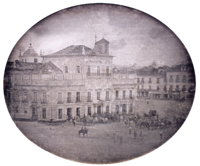
التوحيد
النمو

حرب پاراگواي

السمت

الانحدار
السقوط

الحكم
البرلمان

الامبراطور ومجلس الوزراء
حكم المقاطعات والمحليات
القوات المسلحة
العلاقات الخارجية

الاقتصاد
العملة
استعراض
الجماعات العرقية
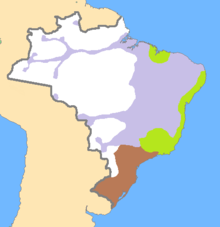
| السنة | البيض | Pardos | السود | الهنود | الإجمالي |
|---|---|---|---|---|---|
| 1872 | 38.1% | 38.3% | 19.7% | 3.9% | 100% |
| 1890 | 44.0% | 32.4% | 14.6% | 9% | 100% |
الهجرة الاوروبية

العبودية
النبالة

الدين
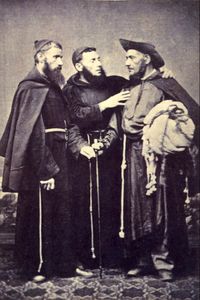
الثقافة
الفنون المرئية

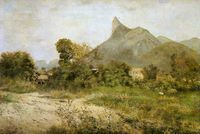
الأدب والمسرح

انظر أيضاً
ملاحظات تذييلية
- ^ During the 19th century, Brazil was divided into only two geographical regions: north (roughly present-day northeast and north) and south (roughly present-day central-west, southeast and south). See Vainfas 2002, p. 39.
الهامش
وصلات خارجية
 Media related to امبراطورية البرازيل at Wikimedia Commons
Media related to امبراطورية البرازيل at Wikimedia Commons
- Pages using infobox country with unknown parameters
- Pages using infobox country or infobox former country with the symbol caption or type parameters
- Portal-inline template with redlinked portals
- Pages with empty portal template
- Articles with hatnote templates targeting a nonexistent page
- نبلاء برازيليون
- امبراطورية البرازيل
- امبراطوريات سابقة في الأمريكتين
- ألقاب نبالة في الأمريكتين
- دول وأراضي تأسست في 1822
- انحلالات 1889




